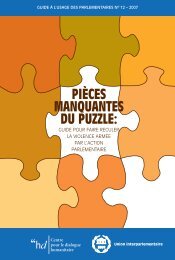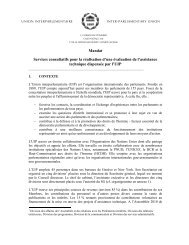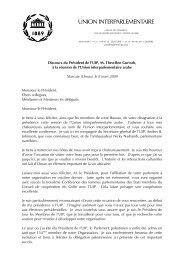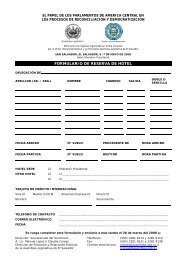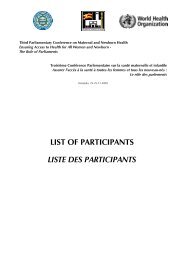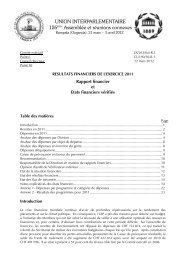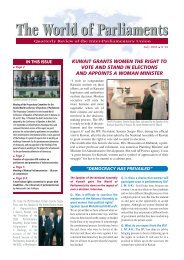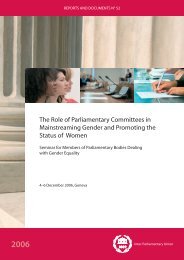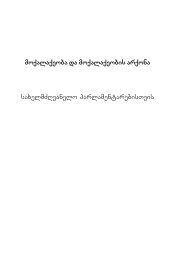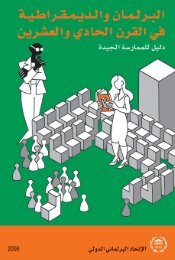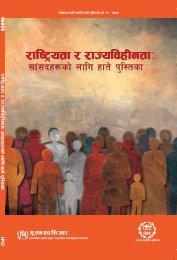MISSING PIECES - Inter-Parliamentary Union
MISSING PIECES - Inter-Parliamentary Union
MISSING PIECES - Inter-Parliamentary Union
Create successful ePaper yourself
Turn your PDF publications into a flip-book with our unique Google optimized e-Paper software.
THEME 2<br />
more serious types of abuses that would give rise to a prohibition on<br />
transfer.<br />
Consideration should be given also to identifying situation-specific<br />
criteria that would address directly the types of cases in which transfers<br />
should always be prohibited. For example, criteria could prohibit transfer<br />
to any state or territory where the <strong>Inter</strong>national Criminal Court is investigating<br />
or prosecuting war crimes or crimes against humanity, or to any<br />
state that has not met minimum international standards in regard to national<br />
use, control, and stockpiling of guns and ammunition.<br />
3. Clarifying the standard of proof<br />
A key question involves determining the standard of proof on the transferring<br />
state. It would seem insufficient to prohibit transfers only where the<br />
state had knowledge that doing so breached the criteria. At a minimum, a<br />
notion of constructive knowledge should be used, whereby if certain factors<br />
were present knowledge or awareness could be imputed. Otherwise, there<br />
is a real risk that states that lack diligence or turn a blind eye to abusive behaviour<br />
on account of a lucrative deal will not be caught by the prohibition.<br />
An alternative to constructive knowledge is the use of the ‘likelihood’<br />
formulation. This is the standard chosen by the EU Code of Conduct. 15 In order<br />
to be useful, this standard needs to be substantiated with indicators. It<br />
could be stipulated that the ‘likelihood’ of arms being used to perpetrate<br />
violations of international law will be assessed in light of statements made<br />
by UN bodies, or will depend on the adoption by the recipient nation of<br />
certain key instruments on, for instance, use of force by law enforcement<br />
officials.<br />
4. Identifying enforcement measures<br />
Too little attention has been given to means to enforce international transfer<br />
criteria. In order to be effective, any international treaty in this area must<br />
include obligations on states to criminalise serious violations, such as the<br />
conduct of national officials who issue licences knowing that the transfer<br />
fails to meet the criteria or the conduct of an arms manufacturer that circumvents<br />
national export controls. Some kind of international monitoring<br />
body will be necessary, as states will often have divergent interpretations<br />
of the criteria. No matter how many indicators are codified in an eventual<br />
convention, there will always be room for disagreement.<br />
An international body or agency would also be a way to guarantee that<br />
a nation wanting to invoke its right to self-defence in order to import guns<br />
and ammunition despite its poor human rights record could argue its case<br />
before a neutral third party.<br />
2. Embargoes<br />
Arms embargoes represent a key instrument to prevent small arms from<br />
falling into the wrong hands. It is now common practice for the UN Security<br />
Council to impose arms embargoes on parties (state and non-state)<br />
to a conflict as a response to the existence or impending threat of violent<br />
47



